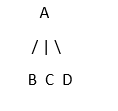Serialize and Deserialize an N-ary Tree
Understanding N-ary Trees
Let's first clarify what N-ary trees are before delving into serialization and deserialization. A tree data structure called a N-ary tree allows each node to have any number of children. Binary trees, on the other hand, only allow for a maximum of two children per node. N-ary trees are extremely adaptable and can be used to represent organizational structures, file systems, and more in a variety of contexts.
Serialization of a N-ary Tree
- Serializing Using Preorder Traversal
An N-ary tree is often serialized using preorder traversal. It entails traversing the root node, recursively serializing each child subtree, and concatenating the outcomes.
- Encoding Using Level Order Traversal
An additional technique for serializing a N-ary tree is level order traversal. It makes sure the structure of the tree is maintained during serialization, which is advantageous during deserialization.
N-ary Tree Serialization and Deserialization Advantages
N-ary trees can be serialized and deserialized to save memory, store data more effectively, and send tree structures over networks, among other benefits. N-ary trees are suitable for a variety of applications due to these advantages.
Serialization Example
Consider an N-ary tree with the following structure:

Practical Applications N-ary trees are used in many different fields, such as:
- Database representation of hierarchical data
- Compilers build syntax trees
- E-commerce platforms' modeling of multi-level categories
- Network Communication
Serialized N-ary trees facilitate effective data transfer between different systems in the context of network communication. The seamless transmission made possible by the compact representation improves system performance as a whole.
- Data Storage
Serialization simplifies complex tree structures into a compact format, enabling data storage. With this compressed representation, storage space is maximized while essential hierarchical information is maintained.
- Algorithm Optimization
An essential part of algorithm optimization is deserialization. Complex calculations and analyses can be streamlined by effectively reconstructing N-ary trees, which improves algorithmic performance.
Steps in Serialization: An Organized Approach
It's critical to adopt a methodical approach in order to master the serialization of a N-ary tree:
- Beginning: Write down the value of the root node first. The serialized representation is built upon this first step.
- Encoding Children: Go through the root node's children, encoding their relationships and values. To distinguish between different nodes, use a delimiter.
- Recursive encoding: Expand the encoding operation recursively to include all N-ary tree levels. The entire tree is accurately represented if the encoding logic is applied consistently.
- Transitional Words: Use transitional words like "next," "then," and "subsequently" to create a fluid flow of information as you move from one node to the next during encoding.
N-ary Tree Serialization and Deserialization's Common Challenges
- Limitations of the Recursive Approach: Particularly for deep or large trees, conventional recursive serialization and deserialization techniques can result in stack overflow errors and inefficiencies.
- Redundant Data: Use of ineffective serialization techniques could result in the storage of redundant data, which would bloat the serialized representation and lengthen the deserialization process.
- Lack of Compactness: Some serialization formats produce a large output that takes up more storage space and slows down transmission.
Code:
Output:
Serialized Tree: A B E F C D G H
Deserialized Tree:
A
B
E
F
C
D
G
H
This code demonstrates how to serialize and deserialize N-ary trees, which can be useful for storing or transmitting tree structures in a compact format.
Optimal Techniques for N-ary Tree Serialization
- Preorder traversal that iteratively: Use a preorder traversal iterative technique for serialization. By simulating the recursive call stack with an explicit stack, this approach completely eliminates the risk of stack overflow.
- Efficient Data Representation: Choose a compact data representation format like Protocol Buffers or MessagePack. These formats reduce redundancy and the volume of serialized data overall.
- Utilize metadata to provide important details about the tree structure within the serialized output. This facilitates effective error handling and deserialization.
|

 For Videos Join Our Youtube Channel: Join Now
For Videos Join Our Youtube Channel: Join Now










